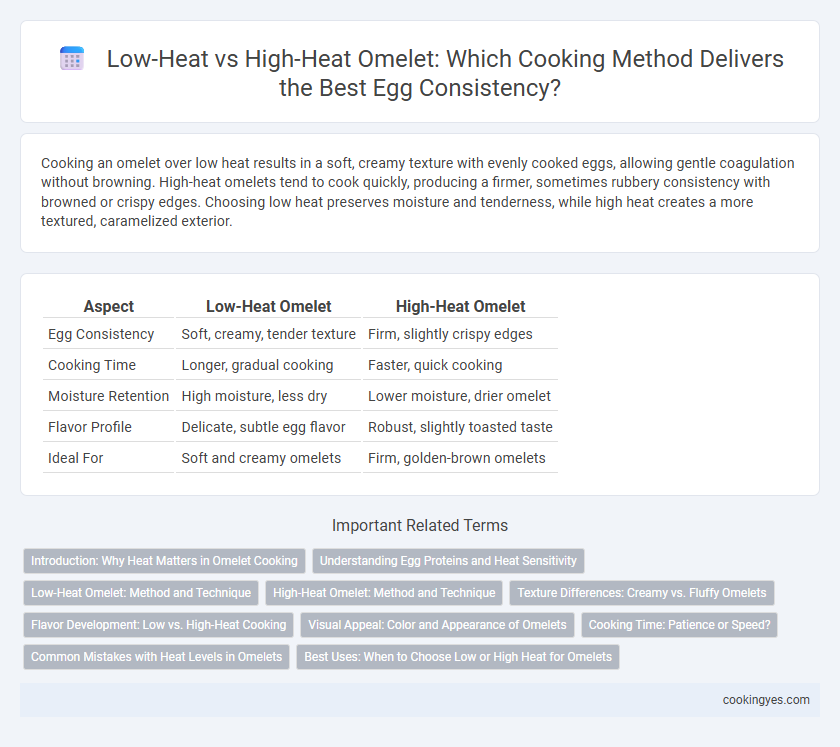Cooking an omelet over low heat results in a soft, creamy texture with evenly cooked eggs, allowing gentle coagulation without browning. High-heat omelets tend to cook quickly, producing a firmer, sometimes rubbery consistency with browned or crispy edges. Choosing low heat preserves moisture and tenderness, while high heat creates a more textured, caramelized exterior.
Table of Comparison
| Aspect | Low-Heat Omelet | High-Heat Omelet |
|---|---|---|
| Egg Consistency | Soft, creamy, tender texture | Firm, slightly crispy edges |
| Cooking Time | Longer, gradual cooking | Faster, quick cooking |
| Moisture Retention | High moisture, less dry | Lower moisture, drier omelet |
| Flavor Profile | Delicate, subtle egg flavor | Robust, slightly toasted taste |
| Ideal For | Soft and creamy omelets | Firm, golden-brown omelets |
Introduction: Why Heat Matters in Omelet Cooking
Heat plays a crucial role in determining the texture and consistency of an omelet, as low-heat cooking allows eggs to cook gently, resulting in a creamy and tender interior. High-heat cooking quickly firms the eggs, producing a firmer, slightly crispy outer layer with a denser texture. Understanding the impact of heat enables precise control over the omelet's final consistency, enhancing the overall eating experience.
Understanding Egg Proteins and Heat Sensitivity
Low-heat omelet cooking allows egg proteins such as ovalbumin and ovomucin to denature slowly, resulting in a creamy, tender texture that preserves moisture. High-heat methods rapidly coagulate these proteins, often causing a firmer, rubbery consistency due to swift protein cross-linking. Understanding the heat sensitivity of egg proteins is essential for controlling texture and achieving the desired omelet consistency.
Low-Heat Omelet: Method and Technique
Cooking an omelet over low heat allows precise control over egg consistency, resulting in a tender, creamy texture without browning. The low-heat technique involves gently stirring the eggs initially, then letting them set slowly, which prevents curdling and creates a smooth, custard-like interior. This method enhances flavor and retains moisture, making low-heat omelets ideal for delicate, fluffy dishes.
High-Heat Omelet: Method and Technique
High-heat omelet cooking involves quickly pouring beaten eggs into a preheated pan set to a high temperature, allowing the outer edges to set rapidly while maintaining a slightly runny center. This method produces a firm, slightly crispy exterior with a creamy interior, emphasizing swift heat application and precise timing. Mastering the high-heat technique requires constant motion, such as folding or stirring, to prevent burning and achieve the ideal fluffy yet textured egg consistency.
Texture Differences: Creamy vs. Fluffy Omelets
Low-heat omelets yield a creamy, tender texture by gently cooking eggs, preserving moisture and preventing curdling. High-heat omelets produce a fluffy, airy consistency due to rapid protein coagulation and steam formation within the eggs. Choosing low or high heat directly influences the egg's structural properties, creating distinctly different mouthfeel experiences.
Flavor Development: Low vs. High-Heat Cooking
Low-heat cooking of omelets ensures gentle coagulation of egg proteins, resulting in a tender, creamy texture with subtle flavor nuances. High-heat omelet preparation accelerates Maillard reactions, producing a more robust, caramelized flavor profile but risks a rubbery or dry consistency. Optimal flavor development balances heat intensity to preserve moisture while enhancing savory notes through controlled browning.
Visual Appeal: Color and Appearance of Omelets
A low-heat omelet develops a uniform pale yellow color with a smooth, creamy texture, enhancing its visual appeal through gentle cooking that prevents browning. High-heat omelets often display browned or slightly crispy edges, creating a contrast in color that can add rustic charm but may result in uneven texture. The choice between low and high heat directly affects the omelet's appearance, balancing between delicate consistency and bold color variations.
Cooking Time: Patience or Speed?
Low-heat omelets require longer cooking times, allowing the eggs to set gently and create a creamy, custard-like consistency. High-heat omelets cook rapidly, producing a firmer texture with slightly browned edges but risk rubberiness if overcooked. Choosing between patience or speed depends on the preferred egg consistency, with low heat favoring softness and high heat delivering a quick, textured result.
Common Mistakes with Heat Levels in Omelets
Cooking an omelet on low heat ensures gentle coagulation of eggs, producing a creamy and tender texture, whereas high heat often results in rubbery, overcooked eggs with uneven consistency. Common mistakes include using excessive heat that causes the outer edges to brown prematurely while the center remains undercooked, and stirring too vigorously at high temperatures, leading to a fragmented omelet. Mastering heat control prevents curdling and promotes a uniformly smooth and fluffy egg consistency.
Best Uses: When to Choose Low or High Heat for Omelets
Low-heat omelets produce a creamy, tender texture ideal for delicate fillings such as cheese or herbs, perfect for a gentle breakfast. High-heat omelets yield a firmer, slightly browned exterior suited for heartier ingredients like vegetables or meats, enhancing flavor through caramelization. Choosing low heat preserves moisture and ensures even cooking, while high heat offers a quick, flavorful finish when time is limited.
Low-Heat Omelet vs High-Heat Omelet for Egg Consistency Infographic

 cookingyes.com
cookingyes.com